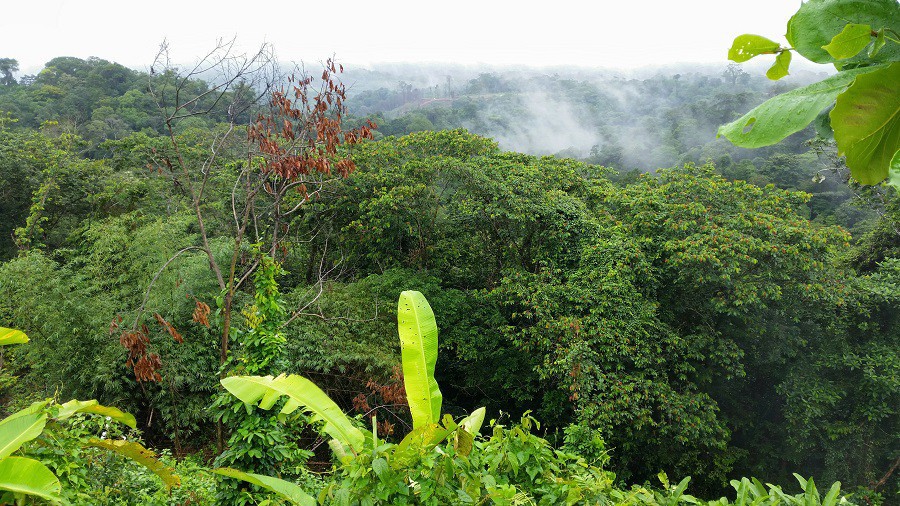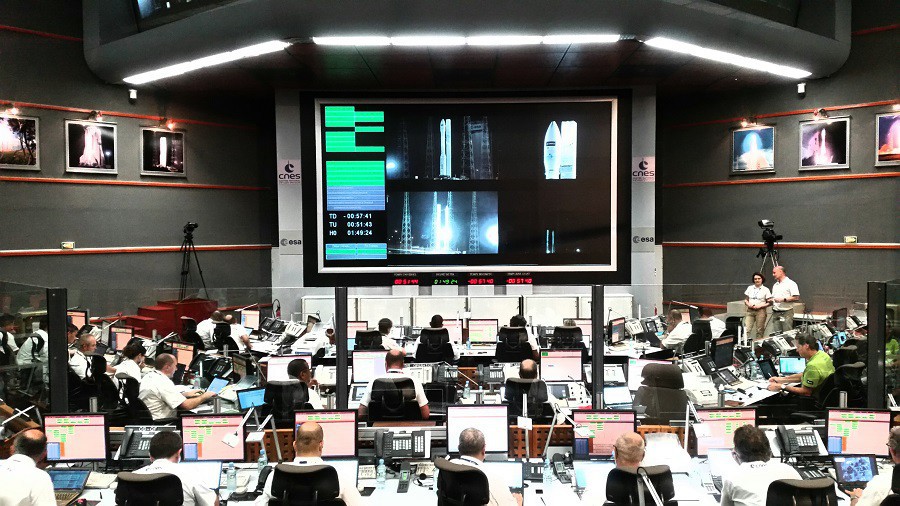Read the exciting interview with Dieter Pikulski, the Copernicus Masters GEO Challenge winner 2015, who experienced the Sentinel-2B launch on-site in Kourou. Get inspired to become a Copernicus Masters winner yourself. This year’s Overall Winner will be invited to attend the satellite launch of ADM-Aeolus in Kourou, which is accompanied by a further cash prize.
Register now to witness this year’s most brilliant Copernicus Masters business cases and winners – just like Dieter – at www.eusw2017.eu/ and don’t miss out on Europe’s biggest space event.
We look forward to seeing you in Tallinn!
About the European Space Week
The European Space Week brings together the most important space stakeholders, companies, partners and visionaries in Europe pushing the topic of space in Europe and beyond. It is organised by the European Commission (EC) under the auspices of the Estonian Presidency of the Council of the EU and co-organised by the European Space Agency (ESA), AZO Anwendungszentrum GmbH Oberpfaffenhofen and Garage48.
5 Questions to Dieter Pikulski
AZO: As winner of the Copernicus Masters GEO Challenge in 2015 you had the unique chance to experience the launch of ESA’s new Sentinel-2B satellite directly on-site at the Guiana Space Center near Kourou, French Guiana. Please tell us a bit about this adventure. How did you experience it?
It was breath-taking. Travelling to a country I didn’t know before is always a great adventure. In this case, it comes as a real surprise: You really have to look twice, in order to realise the beauty of French Guiana. Its cities are either characterised by void or utter chaos – but also by ease, which Europeans in particular may find hard to understand. With its myriads of launch pads, the space mission launch centre in Kourou constitutes a gigantic swathe in the rain forest. Visiting the VEGA launch pad (the “headliner”) is only allowed when bringing an emergency kit. And that’s a little bit scary: After all, you are standing in front of a rocket which is just about 200 metres away from you. Yet, those involved have everything under control. They work together as a good team, as becomes clear in the Jupiter Control centre afterwards. Here, about 30 specialists are busy preparing the rocket launch. Since the launch took place in the evening, I could finally experience a beautiful “sunrise at midnight” from the roof of the centre. It was really breath-taking.

AZO: Many different international parties were involved in the launch and its corresponding event. This surely had an impact on the atmosphere: How did you perceive the other participant groups and the overall ambiance of the event?
The delegation consisted of leading ESA officials, members of the European Commission, representatives of European and national aerospace centres, and a group of international journalists. This delegation was specifically selected, and many of its members were extremely ambitioned: Everyone represented certain interests somehow. Everyone – except me. How phenomenal: Enjoying such a “show” without any ambitions or responsibilities! Being an engineer myself, I was pleased to learn how complexly designed an ignition stage has to be, just in order to have the rocket fly straight. It was a pleasure to have political debates about Brexit – also with representatives of the European Commission, some of which came from the UK. And I of course enjoyed the so called Ti’Punch (rum, sugar water, lime) – the perfect nightcap. Just delicious!

AZO: Did anything surprising happen which you did not expect and which differed completely from your conception or idea of a satellite launch?
Yes, that happened: I did not expect the rocket to lift off that rapidly and gain such an enormous speed. Shortly after the launch, the speedometer showed two kilometres per second. Afterwards (beyond aerosphere) the rocket gained almost 18 kilometres per second. Of course, this is no surprise for a specialist – yet it was for me. Flying from Paris to Berlin within one minute, metaphorically speaking, can be considered a remarkable speed.

AZO: In addition to the access to the launch facilities you also had the chance to experience the dedicated VIP PROGRAM SPECIAL FLIGHT by Arianespace. Please share some of the most exciting programme highlights with us.
Since I had been to French Guiana the very first time, I was already waiting at the hotel when the delegation arrived an hour late. The front side of their bus was greatly damaged due to a car crash with a Jaguar. When hearing about the crash I was a little bit worried about the Jaguar driver’s well-being. Such a bus can be quite massive. Yet I then was told that the jaguar had been run over – and I finally realised that they had been talking about the actual predator all along. I would never have thought of that. Welcome to the jungle! Hence, the programme belatedly started with a welcome drink and an abundant buffet. A casual evening followed – facilitating lots of interesting discussions with representatives from business and politics, the media and the ESA, of course. There were many who had not known each other before. That changed promptly, when they enjoyed the relaxing atmosphere while having a Ti’ Punch. On the actual day of the rocket launch, visits to all launch pads and their corresponding facilities were part of our schedule. Outside the space centre, the security checks which included metal detectors (just like the ones at an airport) occurred whenever we got off the bus. That was more than peculiar. By contrast, we could literally touch the Ariane 5 rocket afterwards. From midday, helicopters flew across the whole area while looking for people who might have entered the danger zone. Furthermore, a large section of the ocean was blocked by the French Army, the Foreign Legion, the police – and even by the US Army. Wow! What an endeavour – just for launching a smaller rocket! The Launch Control Center, the actual control centre for the rocket, was very interesting. Built as a bunker just one mile away from the launch pad, it could be compared to the cockpit of an aircraft. I was spending the evening hours before the launch at Jupiter Control, which could be compared to an airport tower. Suddenly, excitement mixed with enthusiasm arose: After all, almost every spectator was involved in this project one way or the other. Right before the launch the gates opened: Finally, I could witness the fantastic rocket launch VV09 (VOL VEGA – the 9th) from the roof-top terrace of the control centre. The illumination of the night sky reminded me of a sunrise at midnight.
What I enjoyed the most: Our conversations neither became monosyllabic nor rushed. There was always enough time for details. This might have been due to the complexity of the topics – but also to the unique and relaxing atmosphere of French Guiana (30 °C and some rum). I talked with leading ESA- and Airbus technicians about propulsion stages. Joseph Aschbacher (ESA’s Director of Earth Observation programmes), whom I had met in front of our hotel in Kourou at 3 a.m., made time for me and my questions even though it was quite late at night. Following this, I edited my photos and uploaded them for the Live Instagram Story for GEO magazine. After such a long night – with only two hours of sleep –, it was time for the last item on the delegation’s agenda: a trip to Camp Cariacou at the Kourou River. A ride on a pirogue, a long, fast, traditional boat, put us in a great mood. Later on, the European Commission offered us fantastic lunch. Our paradisiac camp in the jungle was rounded out by pouring rain. Due to the weather change, some were more eager to fly back home. However, I stayed in French Guiana for the rest of the week. That allowed me to go on a fantastic voyage into the depths of the rain forest. And since I had rented a traditional wooden cabin beneath the palm trees of Cayenne’s beach, I was definitely envied by most of the delegation members.

AZO: Last but not least: How will the impressions from your stay in French Guiana influence your future life (and work)? Do you have any other upcoming projects related to Earth Observation?
The easy-going Caribbean attitude towards things that cannot – and consequently must not – be controlled directly is remarkable, it has impressed me strongly. After my voyage home, I was confronted with a sort of time lapse in my daily routine which left me completely exhausted in no time. At home people act hectically and feel an unbelievably high pressure to perform. I just hope that I could “export” some of the calmness that I had experienced: I would like to preserve it as long as possible and give my colleagues an understanding of it. It may sound contradictory, but this ease can unleash incredible creative powers and lead to new, yet unthinkable ideas.
In the context of Earth observation, I have many ideas in mind, however, I would like to leave these – and their realisation – to young talents. I hope that the resulting applications can make the world a little bit better.




